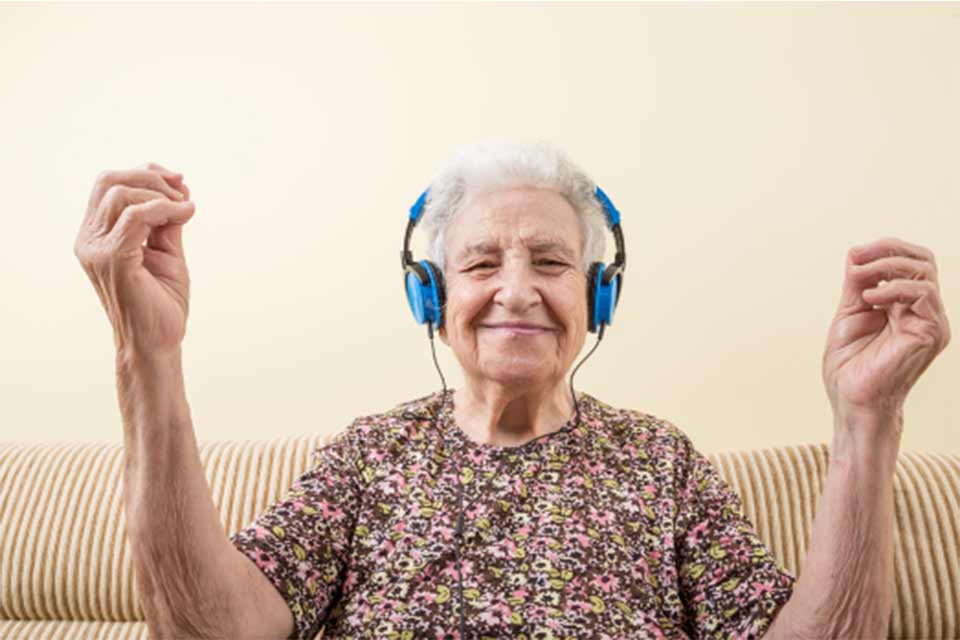
Music Therapy for Dementia

Music therapy helps people with dementia by activating memories and regulating emotions — two key functions that dementia affects. You’ll often find music therapists in memory care communities using songs and rhythms to help residents with dementia relax, exercise, or sleep better. Experts suggest playing songs with personal meaning to spark happy memories, choosing soothing music to reduce agitation, and encouraging interaction like singing and dancing to increase socialization.
Is memory care the right fit?
Let our free assessment guide you to the best senior living options, tailored to your needs.
Key Takeaways
- Music can help dementia patients. Music activates memories and can assist in regulating emotions.
- It’s more than listening to music. Music therapists may ask dementia patients to tap a beat or say how a song makes them feel.
- Family caregivers can use music therapy. Because music is accessible and often free, family caregivers can use music therapy to help their loved ones.
- Use our guide to music therapy. Come up with a personalized playlist and activities for your loved one.
What is music therapy?
Music therapy can look as simple as playing your loved one’s favorite songs from when they were a teenager or stomping on the floor to an energetic beat.
According to the Cleveland Clinic, music therapy is “the use of music and/or the elements of music (like sound, rhythm, and harmony), to accomplish goals, like reducing stress, or improving quality of life.”[01]
Why does music therapy help people with dementia?
“[Music] can be free to use, it helps bring back memories, and it changes a person’s mood and behaviors,” says Scott Smith, a music therapy program trainer and director of education and experience at the Atlanta-based Thrive Senior Living.
The actual science behind why music therapy works for people with dementia is complex. One study from 2023 suggests that the neural networks that store music memory — like melodies, beats, and song lyrics — are usually spared until the later stages of dementia.[02]
Other studies document how music activates the brain’s limbic system, which regulates emotion. When we hear a moving piece of music, our limbic system “lights up,” causing us to feel awe, sadness, or inspiration.[03]
Because two of the most common symptoms for dementia patients are loss of memory and emotional imbalance, music can help by directly influencing the parts of the brain that control both.

Is memory care the right fit?
Let our free assessment guide you to the best senior living options, tailored to your needs.
Cognitive benefits of music therapy
Music can improve understanding, communication, mood, and behavioral disturbances related to dementia, according to a review of several studies on music therapy for Alzheimer’s disease.[04]
The mental benefits of music therapy include:
- Enhanced memory
- Lowered stress levels
- Reduced symptoms of depression
- Reduced agitation and anxiety
- Improved cognition
- Increased socialization
“Music can help a resident retrieve memories or important feelings they had from those memories,” says Scott. “For example, a wedding song can make someone with Alzheimer’s feel the way they did on their wedding day.”
Music therapy activities often have a social aspect, says Kyle Spender, a Learning and Development Specialist who studies both music and sociology. Chair dancing, group drumming, and group sing-alongs use music to build social connections, which has a huge benefit to dementia patients’ emotional well-being.
Kareen King, a creative engagement specialistMusic is a universal language that touches our souls, enlivens our bodies, and connects us to others.
Physical benefits of music therapy
Music therapy can offer physical benefits as well. Understanding how different tempos affect the body and the mind gives caregivers another tool in their toolbox to help their residents.
For example, music with a fun beat can encourage a senior to engage in some light exercise. Low-tempo music, meanwhile, has been shown to reduce blood pressure.
Music can also be used to improve sleep.[02]

Memory care questions? Get expert help
Tell us your care needs to receive personalized guidance from our advisors.
How do memory care communities use music therapy?
Music therapy is a popular activity in memory care communities because it’s effective, easy to use, and inexpensive. Activities directors and music therapists have long known the benefits of using music to help residents with dementia.
“Music is a universal language that touches our souls, enlivens our bodies, and connects us to others,” says Kareen King, a creative engagement specialist who provides therapeutic music experiences to seniors with dementia.
While she regularly confronts the challenges of dealing with dementia limits, King knows she’s making a difference. “For some, therapeutic musical programs are the highlight of their week.”
King suggests three music therapy techniques when working with seniors in memory care communities:
- Play familiar music. Encourage seniors to shake or tap musical instruments to the beat. Instruments can include plastic hand clappers, rhythm sticks, egg shakers, maracas, jingle bells, spoons, or other objects.
- Use a drum to create a firm beat. This provides a strong sound foundation and helps seniors follow the beat or create their own rhythm.
- Interact with the music. Encourage caregivers to sing, dance, or make music with the residents.
What families are saying about memory care facilities
Memory care reviews from residents and families
Poet's Walk Leesburg
Encore Memory Care at Crystal Lake
How can caregivers use music therapy?
Because music is so accessible, family caregivers can use music therapy to help their loved ones wherever they are. Often, music therapy is as simple as listening to music, so picking the right songs matters a lot.
The type of music that works best for people with dementia is music or songs that have personal meaning. In a review of several studies on music and Alzheimer’s, researchers found that personalized music provided the best outcomes in improving mood, reducing agitation, and recall.[02]
“Typically, our music taste comes from our teenage years,” says Scott Smith, a music therapy program trainer and director of education and experience at the Atlanta-based Thrive Senior Living. “Based on the age of the resident, we can determine what era of music would have the biggest impact for them.”
Scott Smith, a music therapy program trainer and director of education and experienceMusic can help a resident retrieve memories or important feelings they had from those memories.
How to build the perfect playlist for your loved one
“I can attest, with some exceptions — music that is familiar and loved by the agitated person somehow naturally and miraculously redirects their emotions and their focus,” says King.
Use these tips to build a personalized playlist for your aging loved one:
- Find songs with personal meaning. Listening to old favorites can bring back joy and make potentially troublesome activities of daily living (ADLs) such as bathing or dressing go more smoothly. Consider wedding songs and favorite bands, or ask relatives if they have any ideas.
- Include music from their youth. Look at the top pop songs from your loved one’s young adult years. For example, if they were born in the 1940s, look at the music charts from the late 1950s and 1960s.
- Use soothing songs to reduce agitation. “We know a lot of agitation comes from pain or unmet needs, but music can promote rhythmic breathing, relaxation, and help someone who may be anxious calm down,” Scott says. Consider instrumental music with a slow tempo.
- Evoke happy memories through sing-along classics. Music can act as a simple and accessible time machine. To help bring back happy memories, look for classic or familiar songs with easy lyrics that your loved one likely learned as a child.
Cleveland Clinic. (2023). Music Therapy.
Bleibel, M., Cheikh, A. E., et. al. (March 27, 2023). The effect of music therapy on cognitive functions in patients with ALzheimer’s disease: A systematic review of randomized controlled trials. Alzheimer’s Research & Therapy.
Jancke, L. (2008). Music, memory and emotion. Journal of Biology.
Leggieri, M., Thaut, M. H., et. al. (March 12, 2019). Music intervention approaches for Alzheimer’s disease: A review of the literature. Frontiers in Neuroscience.
Memory care in all states
The information contained on this page is for informational purposes only and is not intended to constitute medical, legal or financial advice or create a professional relationship between A Place for Mom and the reader. Always seek the advice of your health care provider, attorney or financial advisor with respect to any particular matter, and do not act or refrain from acting on the basis of anything you have read on this site. Links to third-party websites are only for the convenience of the reader; A Place for Mom does not endorse the contents of the third-party sites.
Memory Care options tailored to your needs
Memory Care options tailored to your needs